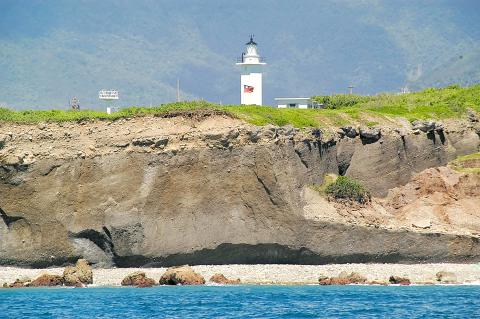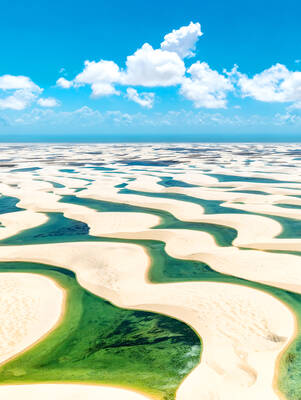The serene and lonesome Cilaibi Lighthouse is the only pentagon-shaped lighthouse in Taiwan. It is located at Cilaibi to the north of Hualien Port. The lighthouse is surrounded by a prairie, hence it is also called “Siba Gaodi.” The lighthouse was built in the sixth year of the Japanese Showa period, or 1931, with the primary function of giving directions to vessels navigating the ocean around Cisingtan.
During World War II, the lighthouse was bombed by Allied jets and therefore could not shine its light as normal until 1963, when the government upgraded Hualien Port’s status to an international port and built the pentagon-shaped white lighthouse on the old site.
Cilaibi Lighthouse is administered by the Maritime and Port Bureau under the Ministry of Transportation and Communications. The interior of the lighthouse is not open to the public. However, visitors can take pictures of themselves with the lighthouse and at the same time enjoy the view of the Central Mountain Range and a bird’s eye view of Cisingtan Bay.

Photo: Yu Tai-lang, Liberty Times
照片:自由時報記者游太郎
(Liberty Times, translated by ETHAN ZHAN)
寧靜孤寂的「奇萊鼻燈塔」,是台灣唯一的五角形燈塔,位在花蓮港北方奇萊鼻處。燈塔周圍是一片大草原,因此也有人稱它為「四八高地」。燈塔建於昭和六年,主要功能是為航行於花蓮七星潭海域的大小船隻指引方向。
二戰期間,燈塔受到盟軍飛機轟炸,導致無法執行發光作業。直到民國五十二年,政府將花蓮港升等為國際港,於是就在原塔基附近,新建現今的白色五角形燈塔。
「奇萊鼻燈塔」現由交通部航港局管轄,塔內並未對外開放,但民眾可與燈塔合影留念,同時遠眺中央山脈群及俯瞰七星潭海灣。(自由時報記者王峻祺)

China commemorated 80 years since the end of World War II last week with a massive military parade against a backdrop of a disputed history about who ultimately defeated Japan. The issues, including Japan’s reckoning with its wartime record in China, are bound to flare again in December, a flashpoint anniversary of the mass killing in Nanjing by invading Japanese troops. Below is an explainer about what the different — and disputed — points of view are. WHAT IS CHINA’S VIEW? For the Chinese government sitting in Beijing, this is a clear-cut issue: China sacrificed 35 million people in a heroic and brutal struggle

Rarely does Nature present such a striking contradiction as the one found in Lencois Maranhenses National Park. Located along Brazil’s northeastern coast, the park unveils breathtaking scenery, where rippling sands meet crystal-clear lagoons. Under the sun’s golden glow, the waters glitter in shades of turquoise and emerald. So surreal is this spectacle that visitors might wonder if they’re gazing at a digitally modified photo rather than a living landscape. Were it not for the unique geographical and climatic conditions, such a marvel would not exist. Unlike typical deserts, Lencois Maranhenses receives a substantial amount of rainfall, particularly during the rainy season

In a major step to combat carbon emissions, Norway’s pioneering “Northern Lights project” is set to expand its carbon capture and storage (CCS) capabilities. Backed by energy giants and the Norwegian government, this collaborative project is working to increase its annual carbon storage capacity from 1.5 million to over five million tons. Northern Lights focuses on capturing CO2 emissions from industrial sources across Europe and securely storing them underground. Captured CO2 will be liquefied and transported by ship to the storage facility located off the coast of Norway. It will be injected through pipes into geological formations about 2,600m below the

1. 我和他相識已經九個月了。 ˇ He and I have known each other for nine months. χ I and he have known each other for nine months. 註:單數的不同人稱代名詞連用,其次序一般是 you and I、you and he、he and I、she and I。複數人稱代名詞的次序是 we and you、you and they、we, you, and they。 2. 我自己不願意去那家公司工作。 ˇ I myself am unwilling to work in that company. χ Myself am unwilling to work in that company. 註:myself、yourself、himself、herself、itself、ourselves、yourselves、themselves、oneself 等反身代名詞可用來加強語氣,但必須跟在其所加強的人之後,不能單獨出現當作代名詞用。 I myself went there. I’ll do it myself. He did it himself. 3. 沒有人知道這件事情。 ˇ Nobody knows about this. χ No body knows about this. 註:nobody 不可寫作 no body;同樣 anybody、somebody、everybody 都不可以分開來寫。說「沒有人」,用 no one 或 none 都可以。 4. 我會把自己的書送給他。 ˇ I will give my own book to him. χ I